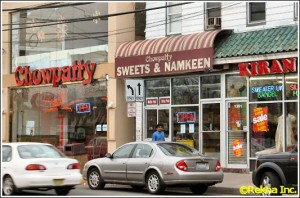
"Little India"
I haven’t missed home much during the past two weeks. We have been so busy with tours and museums and plays that I simply haven’t had time to be homesick–until yesterday and today. London’s East End and Southall reminded me so much of my hometown that I couldn’t help but long for good old Iselin, a place I took for granted before I came to college.
The town I’m from is extremely diverse and has a large South Asian population. For example, the top languages spoken in my high school (as of 2008) are English, Gujarati, Spanish, Urdu, Panjabi, Hindi, and Tagalog. Oak Tree Road and Green Street, the two main roads running through Edison and Iselin, NJ are lined with sari shops, curry houses, cash and carries, and more. The annual India Day Parade is the biggest event around and Bollywood stars are commonplace on billboards.
Growing up, I never really realized or appreciated the cultural diversity I experienced on an everyday basis. Even though the Indian/Bengali population has left the greatest mark on my area, there are numerous people of other backgrounds who reside in my area. The example I often use to make this point is if you come to visit me, I can find ANY kind of restaurant you can think of (Indian, Japanese, Chinese, Thai, Greek, Mexican, Spanish, Kosher, Portuguese, Mongolian, Polish, and Ethiopian are the ones I can list off the top of my head). Before coming to Dickinson and Carlisle, I never really thought about how much of the rest of the United States is, in fact, not like this at all.
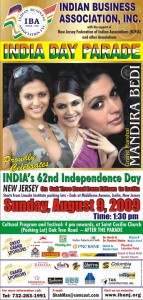
Advertisement for the India Day Parade on Oak Tree Rd.
Living in such a culturally diverse place has not always led to positive experiences. As we’ve seen and heard of in London, there is a lot of ethnic tension in my area due the sudden boom of immigrants that started in the 1990s. I’ve heard my friend’s parents refer to their neighbors as the “terrorists down the street,” and “dot-heads,” “deets,” and “hajis,” are only a few of the pejorative terms heard on a regular basis. I remember one of the blog posts mentioned an altercation between a white man and a South Asian man in a market, which reminded me of a time I was in the Target by my house and a white man shouted at the Indian man in front of him in line to, “go take a fucking shower and come back when you know some fucking English.” Another friend’s mother claimed that the Indians “stole” our Christmas light and use them for their holidays, disregarding the fact that Diwali is the Festival of Lights and electric lights are common decorations for purposes other than Christmas. I’ve even lost one friend within the past year because I refused to put up with his increasingly racist comments any longer.
I hope that this relatively new immigrant group will in time become more accepted in both American and British society. However, I might be rather pessimistic or cynical, as I can’t help but think that a new population will replace the lowest rung on the social ladder once this is allowed to move up. What I know for sure, though, is that all I can do is my part to try to fight intolerance and racism so that people might realize all of the wonderful things various cultures have to offer.
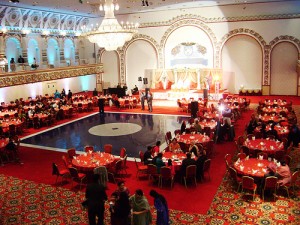
Royal Albert's Palace--An Indian catering hall where my friend had her Sweet 16
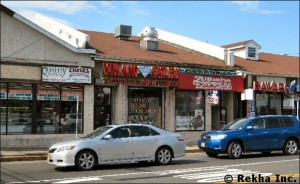
Oak Tree Road
Categories: Sarah
Tagged: Diversity, East End, Immigration, Iselin, Little India, Oak Tree Road, Racism, southall
I believe that ours has become a culture of fear. Not only, but especially since 9/11, we have begun to fear those of different cultures and those of different appearances, more than I think we ever have before. While many of you may find this a very controversial statement, I think it has become a truth that we all live with everyday. As students in a foreign country, we spend our time fighting this growing reality. We study other cultures, we learn about the unknown so that we will not fear it. But ultimately, Americans live in a society that is suspicious of the unknown.
So when we entered the Sikh Gurdwara in Southall, I’ll admit I was uneasy. However, it is not about that uneasy feeling, the uncomfortable awareness of difference, that I mean to write about tonight, but rather something that our generous guide earnestly said to us. After covering our heads, removing our shoes, washing our hands, touring the Gurdwara, and hearing about the Sikh faith, Professor Qualls asked our guide about the traditional kirpan sword that practicing Sikhs would normally wear at their side at all times. The guide did explain –to my understanding—that they are allowed to wear them on the street etc, because it part of their faith and is not considered a weapon. However, he did note that they are still not allowed to travel with them on airplanes. He stated that, “[Sikhs] sometimes stand out because of what we wear. People may see us with a kirpan and think we are going to try to take over the plane. But it would be better if we could take them because if someone were to try to take the plane, we would be able to stand up and say ‘no! do not do that!’ I know that someday we will be able to take them with us when we travel. People will see us with it and say, ‘No, he is a Sikh, he will not hurt us. Let him have it.” Perhaps I am more of a jaded American city girl than I ever thought, because hearing this man honestly tell us this belief for the future moved me more than anything else said that morning.
Part of the Sikh tradition is to protect the innocent. They carry this sword with them at all times because it is their duty to protect themselves and those who cannot protect themselves. This man had such faith in the British people, in the American people, in the growing cultural world, that someday he saw people not only accepting his faith, but understanding and allowing him to practice all the aspects of it, even if it involved carrying weapons.
It was a deeply powerful moment, to feel someone else’s hopes, however naïve you may think them, and to know, that are not in any future you foresee. As much as this experience in another culture, which despite similar languages is very different from my own, has opened my eyes to many wonderful differences and helped me to be even more accepting, I do not know that I can believe the same openness is possible on a worldwide scale. After all, we are a people who are afraid of differences. And while that can change one person at a time, we still have a long way to go.
Note: No photographs were allowed in the temple so I did not bring my camera along on this trip. However, if you would like to see images of the area, check out Google Images of Southall.
Categories: Megan
Tagged: cultural acceptance, gurdwara, religon, Sikh, Sikhism, southall
Interspersing our travels from pub to pub for our walking tour, we decided to take a much needed Americana break. And what better place to go for a greasy, cheap Yankee fix than good old Mickey D’s. Before we even entered the restaurant, the not-so-subtle differences between McDonald’s in America versus Europe were apparent. One of the most distinguishing characteristics of an American McDonald’s is the ever prevalent red and yellow coloring, clinically proven to be associated with hunger and increased stimulation of the senses. Billions and billions served, right?
Another key aspect of any McDonald’s is their uncomfortable seating and their open dining areas. The seating in American McDonald’s are intentionally uncomfortable because they want you sit, eat, and get out as soon as possible in order to accommodate the next wave of kids with the munchies. The open areas perpetuate this with feelings of nakedness and over-exposure. In stark contrast, the McDonald’s here in London has a greenish brown color and a much different architectural design. Instead of one big open space, it was split into two relatively cramped floors furnished with cushy chairs on the lower level and long tables, comfortable stools, and a relaxed, cafe style sitting corner on the upper floor. This is most likely done in an attempt to fit in with the chic surroundings of the European cheap eating market. The menu above the counter featured “The M,” which is essentially a glorified quarter pounder with cheese, except much pricier and on a ciabatta roll. But it was advertised in such a pretty font! They also had free wi-fi, which is sweet.

From http://snackspot.org.uk. So succulent. So overpriced.
From http://snackspot.org.uk. So succulent. So overpriced.
This brings up an important difference between American and European eating habits. Fast food back in the States is called fast for a reason. Customers generally don’t spend hours on end sitting in a Burger King. Drive-thrus come standard with every establishment. I have seen literally one drive-thru since I’ve been here. It seems that the European equivalent of the American fast food burger joint is the cafe. Pret a Manger and Eat cafes, not McDonald’s and Wendy’s (although there are a surprisingly large quantity of KFCs) dominate the cityscape. Cafes go hand-in-hand with the laid back attitude so prevalent in this continent.
This is a photograph of a London McDonalds. The one following is American.

http://coolboom.net/en/wp-content/uploads/2007/09/mcdonalds-london2.jpg

http://www.norh.com/news/0904/news-0904/insidemcdonalds.jpg
There is no way an American style McDonald’s could survive in London. The McDonald’s at St. Paul’s was sandwiched between two cafes. The decor and atmosphere of the restaurant effectively fit in with its distinctively European neighbors. The stereotypical American McD’s – bright, noisy, grungy, and crowded – would wither and die in the face of the far superior and definitely healthier European chain cafes. And although the fatty, disgusting-but-oh-so-good food is exactly the same, the atmosphere makes us feel healthier, and thus happier. Perhaps if the fast food places of the United States were more like the ones here they would not have such a negative reputation. Or maybe more cafes like Pret ought to pop up on our streets back home. Who knows?
Categories: Andrew B · Andrew F · Andrew R · Campbell
Tagged: Americana, McDonalds
Over the past year I found myself challenged with the question, “what is art?” I spent my entire time during my class, “The Politics of the Body: History & Improvisation” , last semester, arguing that very few of the performances we were observing were “art”*. However I have broadened my opinion on this subject matter and have recently opened my eyes to new definitions of “art”.
Last spring I categorized “art” into a few major categories: dance, music, theater, paintings, and sculptures. However as I began viewing more variations of art and have further discussed this huge question with my professors and my peers my definition of art has varied greatly. I would still consider the standard categories of art set, however looking into more performance art I find that definition to be much more shaky.
Thinking back at some of the things I have seen around London recently I began to think especially about performances and what is “art” in these terms. The first thing that I saw that I considered a performance was a changing of the guards that I saw near Parliament. The planned out speeches, the floor patterns, the intricate planning that comes with these ceremonies– it’s hard not to consider them a type of performance. There are also all sorts of styles, plans, and different organizations that plan out these ceremonies. A performance, yes. But is it art?
The following day I was in the same general area, over near Trafalagar Square, and someone pointed out the fourth ‘incomplete’ pillar. I had not noticed that there was always one person replacing one of the statues. The ‘performers’ do all sorts of varying things: dancing, singing, standing still dressed as Darth Vader, hitting small objects into the crowd, etc. Depending on what these people do can you consider them performers? And if we consider them performers are they artists? Is what they’re doing art?
So I still have no real definition of “art”. I still don’t know what I would consider “art”. But I’m working on it, and probably will continue to struggle with it for quite some time.


*I am choosing to refer to art in quotes, beause this entire post is an arguement (with no real conclusion) about what one could consider “art”.
Categories: Amanda
Tagged: Art, Changing of the Guards, performance
Through reading the syllabus beforehand, yesterday and today were two days I was most looking forward to on this trip. Two semesters ago I had taken a class called, What is Hinduism?, at Dickinson and there my love and appreciation for any kind of religion has grown. I was really excited to go to the Sikh temple today because I have some background knowledge on religions in India.
What most interested me in both some parts of Hinduism and Sikhism is their desire to eliminate distractions from your life. I find this task very admirable, being that I am constantly distracted in general and have trouble focusing, even at church. I know with Hinduism that to achieve this goal is called moksha, to be liberated from the cycle of life or samsara through reincarnation (which is generally thought of as a bad thing in Hinduism). To try to explain complicated concepts of Hinduism in two sentences is not easy, so for more information I suggest you look here. Sikhism as well seeks to achieve salvation through disciplined meditation in order to understand God and His messages. I have tried meditation once in my life and I know how difficult it was for me to focus on nothing or on one thing without getting distracted by a fleeting thought. I have such a deep respect for those that can devote their lives to meditation and focusing solely on their religion. At one point our guide was telling us about the five types of distractions that hinder your devotion to God. These distractions are called Maya or “unreality” and are known as greed, lust, ego, attachment and anger. It was interesting to see that parallel to our very similar “seven deadly sins.”
Another part of the day that I enjoyed was how the temple was so simple and uncluttered. After going to both St. Paul’s and Westminster Abbey, where the entire church is filled with statue, memorials, graves, etc it was a nice change to see just plain white walls. Even in the Hindu temple I had been in before, the walls still had big paintings of gods like Krishna. The Sikh temple made it easier to focus on the beauty of their religion, through the lovely songs of devotion drifting in and out of your consciousness and hardly any forms of art to distract you from paying attention and meditating.
What really saddened me in the end was how people can have such a negative impression when they see someone wearing a turban or any sort of South Asian clothing without knowing their background. They probably wouldn’t even know that they maybe are a Sikh, a very welcoming and passive community and religion. Reading in the pamphlet our tour guide gave to us, a quote stuck out to me. A man comments upon the Sikh community as being “very large hearted” and that “in spite of racial differences they co-exist with others happily.” As much as I felt like I stuck out in the temple, I felt a sense of welcome despite my awkward feeling. The fact that they allow anyone to come in and eat, Sikh or non-Sikh, is very nice of them. I would have thought that they wouldn’t want any outside influences, but instead they welcomed it. Even when I went to the Hindu temple before, the people there were so open and willing to teach us about their religion and have us participate. It is days like today that I realize how beautiful religion can sometimes be.
Categories: Alli
Tagged: devotion, Diversity, Hinduism, Sikh, Sikhism, Temple
-
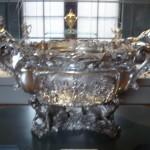
-
Giant Silver Punch Bowl at the V&A
-

-
The Theatre and Stage Exhibit at the V&A
-

-
Brandon and I before Arcadia
-

-
Outside the National Theatre
This Monday I experienced my first bank holiday. Because of our full schedule here this month it didn’t seem any different from any other day here. This held true until I wandered down Tottenham Court Road and realized that just about everything was closed. With just a handful of museums open I decided to use the time to visit one I hadn’t been to yet: The Victoria and Albert Museum.
I had been told great things about the V&A museum by classmates who had been there within the past few days so I went in with pretty high expectations. After seeing the first exhibit based on Great Britain from the 1600’s-1800’s I was not impressed. Boy would this opinion change. I walked up to the first floor and entered a giant gallery filled with all kinds of sculptures. This was easily the best sculpture gallery I had seen so far in London and I spent about 15 minutes walking through it and admiring. As I continued to walk through the entirety of the first floor I was absolutely astounded by the variety of exhibits this museum had to offer. Some highlights included a detailed exhibit on fashion, a room filled with giant monuments including a cross and decorative pillars and an exhibit on the Middle East and its textiles.
After a good hour spent on the first floor I ventured up to the third floor of the museum. As soon as I stepped into the silver exhibit I was in awe. I spent at least a half an hour admiring and studying silver used and manufactured in different time periods and parts of the world. My favourite was a giant punch bowl made entirely of silver. There were many other exciting exhibits on the third floor including one on theatre and a print exhibit featuring one of my late grandmother’s favorite authors, Beatrix Potter. My last stop on the third floor was the jewelry exhibit. In addition to being aesthetically pleasing the exhibit featured a timeline of jewelry that was considered fashionable since the start 18th century and a few small personal collections.
I could have spent at least another three hours in the Victoria and Albert museum but I decided to hold off for another day. The thing that impressed me the most about this museum was the variety of exhibits. Just about every other museum I had visited so far in London I knew what to expect going in. The V&A featured anything and everything and had no qualms about doing so. I found this both refreshing and exciting.
The rest of my bank holiday was filled with a trip to the theatre. Upon request the entire class got “dolled up” for a performance at the Duke of York’s Theatre near Leicester Square. We saw Arcadia, a Tom Stoppard play that turned out to be both extremely funny and thoughtful. The class seemed a bit skeptical of how the play would be at first glance since we couldn’t see much of the stage but as soon as the curtain went up things improved immediately. Neil Pearson’s performance as Bernard Nightingale was unmatched and fit perfectly with Samantha Bond’s character of Hannah Jarvis. The play was not only entertaining and made me think but also fit in perfectly with our program since it contrasted the humanities and sciences.
Ever since seeing Troilus and Cressida last Friday I have been craving anything to do with the theatre. This happened to be perfect timing as we spent all of Tuesday focusing on the stage. In the morning we had a fantastic conversation with Rick Fisher , a Dickinson alum of 1979 and a recipient of two Tony Awards, most recently for his work on Billy Elliot: The Musical. It was fascinating speaking with a Dickinson graduate who had simply worked his way up from the very bottom of the London theatre scene.
In the afternoon the class toured the National Theatre. Our tour guide took us through all parts of the building including the three main theaters. The Olivier, which is the largest, seats about 1100 people and does not have a bad seat in the house. My favorite part about the Olivier was that the main stage could be divided in half and raised and lowered at any time. In addition to the Olivier we also viewed the Cottesloe Theatre a black box that has the capability of being transformed into just about anything. All of the chairs in front of the stage can fold down and the risers they sit on can be pushed in creating additional stage space. The tour guide described a play that had been recently performed in the Cottesloe where the actors were mixed in with the audience. This amazed me. We also viewed the Lytellton Theatre where our class will be viewing the Pitmen Painters together next week. The other part of the tour that really amazed me was the props department. From the crocodile in Peter Pan to a severed head no prop was impossible to create.
After the tour of the National Theatre many of us were so excited about coming back that we decided to go see Shakespeare’s All’s Well That End’s Well, the play taking place in the Olivier currently. My reaction to the play was mixed. The theatre itself was amazing. The props, sets and lighting blew my mind and the acting was good overall. Despite all of these positives I didn’t particularly enjoy the actual play, especially the ending. It seemed impractical to me and unlikely to happen in real life, even 500 years ago.
Overall learning about theatre in London has been a lot of fun. In addition to seeing a variety of shows we’ve gotten a chance to see London theatre from many different perspectives. From the traditional globe experience to hearing about small fringe productions from Rick Fisher to a tour of all three main facilities at the National Theatre we have received a wide perspective of how this popular activity has influenced the city as a whole and in all different ways, shapes and forms.
Categories: Henry · Museums · Theatre
Tagged: All's Well That Ends Well, Arcadia, National Theatre, Olivier Theatre, Rick Fisher, Victoria and Albert Museum
Today was a day filled with the inner workings of British theatre. I began my day with an early morning walk to a nearby Starbucks. I ordered my usual Caramel Marchiato with extra caramel, in order to get myself prepared for a fun filled day learning of British theatre. On my walk back to the hotel, I pondered what today’s adventure would bring? Once I arrived at the hotel it was time to begin our discussion with a Dickinson Alumni.
Rick Fisher class of 1979, attended Dickinson college and in his first semester of senior year traveled abroad to London. During this time he fell in love with the theatre and when he graduated moved to London to pursue a career in the theatre. Since then he has two Tony Awards for his lighting direction in one particular play Billy Elliot, and a second one I cannot remember. As he was speaking today about his journey as he worked his way from the bottom of the barrel to becoming a Tony Award I could not help but think of my own future goals after college to become a professional dancer and choreographer. I never thought of Dickinson as a institution in which one could professionally develop a career in the arts, but after hearing of Rick’s journey, it has now become a possibility that is not beyond reason. His words and passion for his career, inspired me to further carryout my plan to dance after my Dickinson education ends. As he informed us, the business is not an easy one, but his dedication, and love for the theatre made me realize that the challenge makes it all the more rewarding.
At 11:30 the class broke for a quick lunch and then headed out for a tour of the National Theatre. Our tour guide did a phenomenal job taking us about the massive structure, as she explained how not only the productions were made possible, but of how much goes in to putting on 6-9 productions a day. It never occurred to that so many intricate details when in to putting on a play. As we toured through the national theatre, our tour guide stripped down, our fantasy world of what we all imagined the theatre to be, and showed us how the work of everyone was important to putting on a successful production. The tour was very similar to the Walt Disney/Warner brothers tour of the lot in Los Angeles California where they film major Hollywood television shows. On both tours the tourist is able to get a real sense of not only the work of the actors but the work of the collective, it is a realization to an audience member that so much is required for a production of this scale, just for our entertainment.
Following the tour the group headed back to the hotel, and capped of the night with the play, All’s Well That End’s Well. After learning of all the intricacies to making a play I was able to appreciate the work all the more. From the acting, lighting, costumes, props, and everything in between, the performance was astounding. The only problems I had with the play was the ending. For the sake of my fellow peers that will see the production in the near future, I will not ruin the ending however, I will say that the lead female is the dumbest girl in Shakespearian history. Still production was enjoyable, and having been in the theatre just hours before the set was up, it was great to see the final piece of the production. An experience I won’t soon forget.
Categories: Anthony
Tagged: Scenery, Shakespeare, Theatre. Lights
One thing that I have been noticing a lot about London is the accessibility and services available for people who are disabled or handicapped in some way. Much like what you would tend to expect from American cities, there are handicap accessible entrances, ramps, elevators, and automatic doors leading to many of the major museums and tourist attractions around London. However, I have observed less-than-wonderful wheelchair-friendly services in the Tube stations.
Looking at the Underground map, there are only 9 stations within Zone 1 that have step-free access from the platforms to the outside world. Now, I grant that the map shows that the bigger stations or those with rail stations attached tend to have wheelchair accessible facilities, but there are still a number of problems. First, there’s the gap to mind, which while it is not beneficial to the elderly or buggy-pushers, seems to be a very large potential problem for people in wheelchairs and using crutches to get over. Secondly, with the current construction projects occurring at many of the major Tube stations, some facilities that would normally be easier to maneuver around are currently out of order. The only saving grace of the transport system for those movement-impaired seems to be the bus system. From what I have noticed of the buses, the majority of them are fitted with a hydraulic system that either allows the bus to be lowered curbside or a platform for a wheelchair.
Despite my criticisms of the Tube as a vehicle of transport for people in wheelchairs, London has managed to greatly surprise me in the leaps-and-bounds of services for other handicapped peoples. When I was at the British Museum the other day, I noticed a sign that mentioned that there is a Touch Tour for people who are blind or visually impaired. I’ve never encountered anything like this before, but think that it is a brilliant idea! This tour allows them to touch specific objects in certain sections of the Museum in order to get an idea of what the art from that culture “looks” like. Accompanying these objects were plaques in Braille explaining the object they were “looking” at.
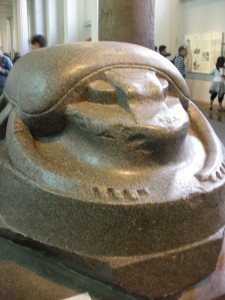
Scarab from the Egyptian section of the Museum - on the Touch TourSign for the Blind Touch Tour
I was struck again by the services provided for disabled/hard-of-hearing peoples tonight at the performance of All’s Well That Ends Well at the National Theatre. One of the last things I was expecting when I entered the theatre was to have a closed captioning screen for the play! Despite this service being aimed at those deaf/hard-of-hearing people, I benefited greatly from being able to see some of the dialogue I missed either by zoning out or simply not being able to hear. Although I did find the screens slightly distracting at times, I think that it was a brilliant idea that should be implemented at many more theatres in the world.
Overall, I am finding London to be a very mixed city of accessibility and services for people who are disabled or handicapped in some way. I think that the Tube stations need some work, but as construction is constantly being done on them, I know that they will be improved upon eventually. On the other hand, I think that the Touch Tour and the closed captioning in the theatre were both wonderful ideas that should be implemented in the States and around the world if they haven’t already. Any thoughts or observations on services and accessibility?
London is a city where the past is constantly present. What do I mean by that? Different countries maintain a dialogue with their history in a different way. Some countries are older than others. For example, in Argentina, where I come from, there are some plaques and monuments, but not so many as in England. One of the obvious reasons is because Argentina is a much younger country of only 200 years, and therefore has less history. But I do not think this is the main reason. In London, I get a feeling that time is cyclical, and that history comes back to us in many forms and shapes. We see it present on the street, in houses, in museums, in pubs and in its people.
During our trip, Prof. Qualls has been using the word juxtaposition. Indeed, in London we have found that not only architecture presents juxtaposed old and new buildings, but also different situations, like the helicopters during our play at the Globe theatre. I want to use a more complicated word which I am not sure if I made up since I am translating it from Spanish: trans-textuality. By this I mean the dialogue between two texts or two authors. While this is common in literature since most texts have their foundations on previous texts, it is a technique that is most common in Shakespeare and that I’ve been founding in London in general. This idea that if we build a new building, we will find the remains of others. Like we saw on our Roman walking tour. If a family moves to a new house, they will probably discover who lived there, like we saw in our Bloomsbury walking tour, and the many plaques saying the personalities who lived in the different houses. If I go see a play, trans-textuality is always there. It can be Troilus and Cressida, a story built inside another story (the Trojan war), or Arcadia, by Tom Stoppard, which also dialogues with the past and real life English characters such as Lord Byron.
Being in a city as old as London makes me constantly question about the past, from who has lived in what we now know as the Arran House Hotel, to what will my mark be, as the story of London progresses.












